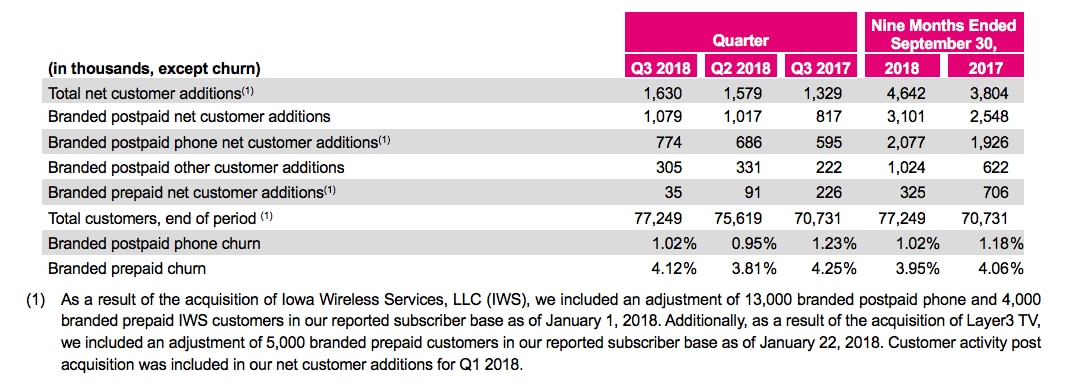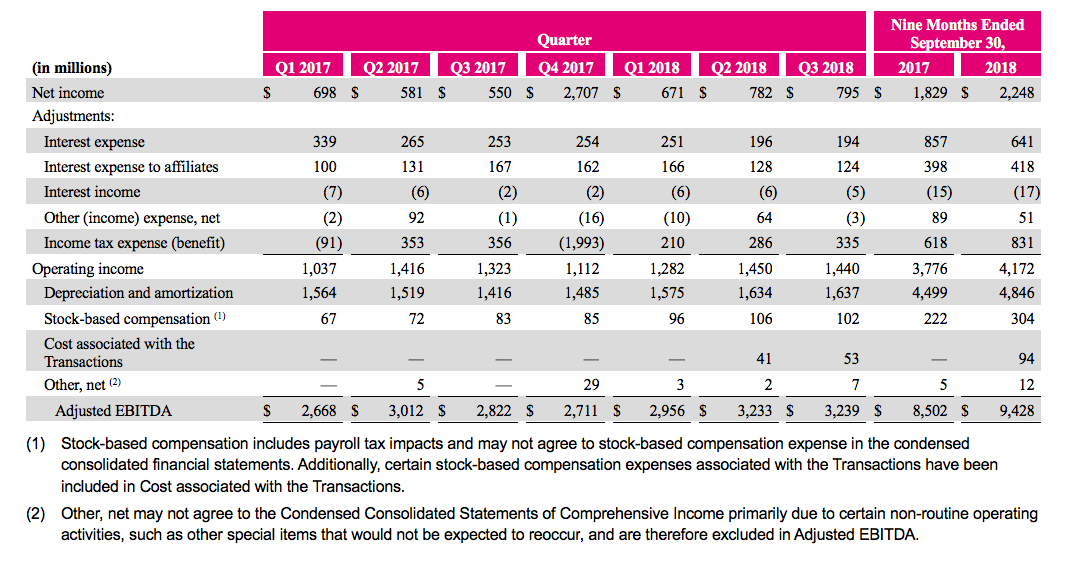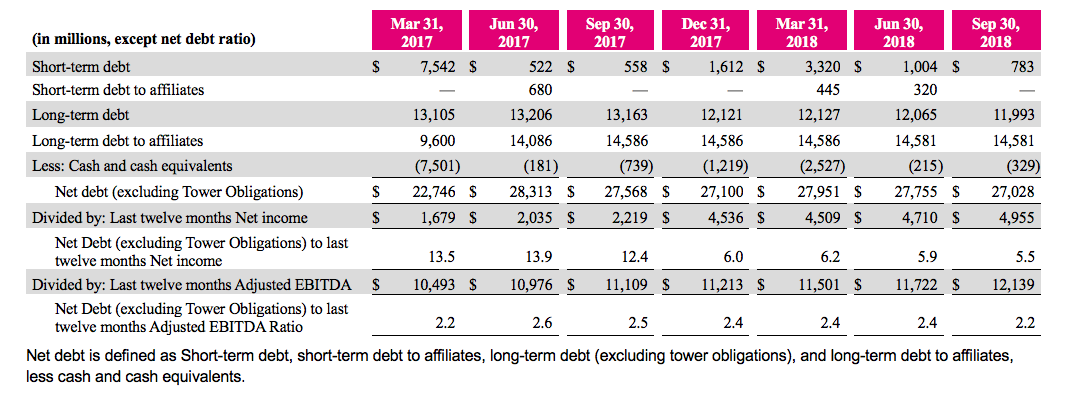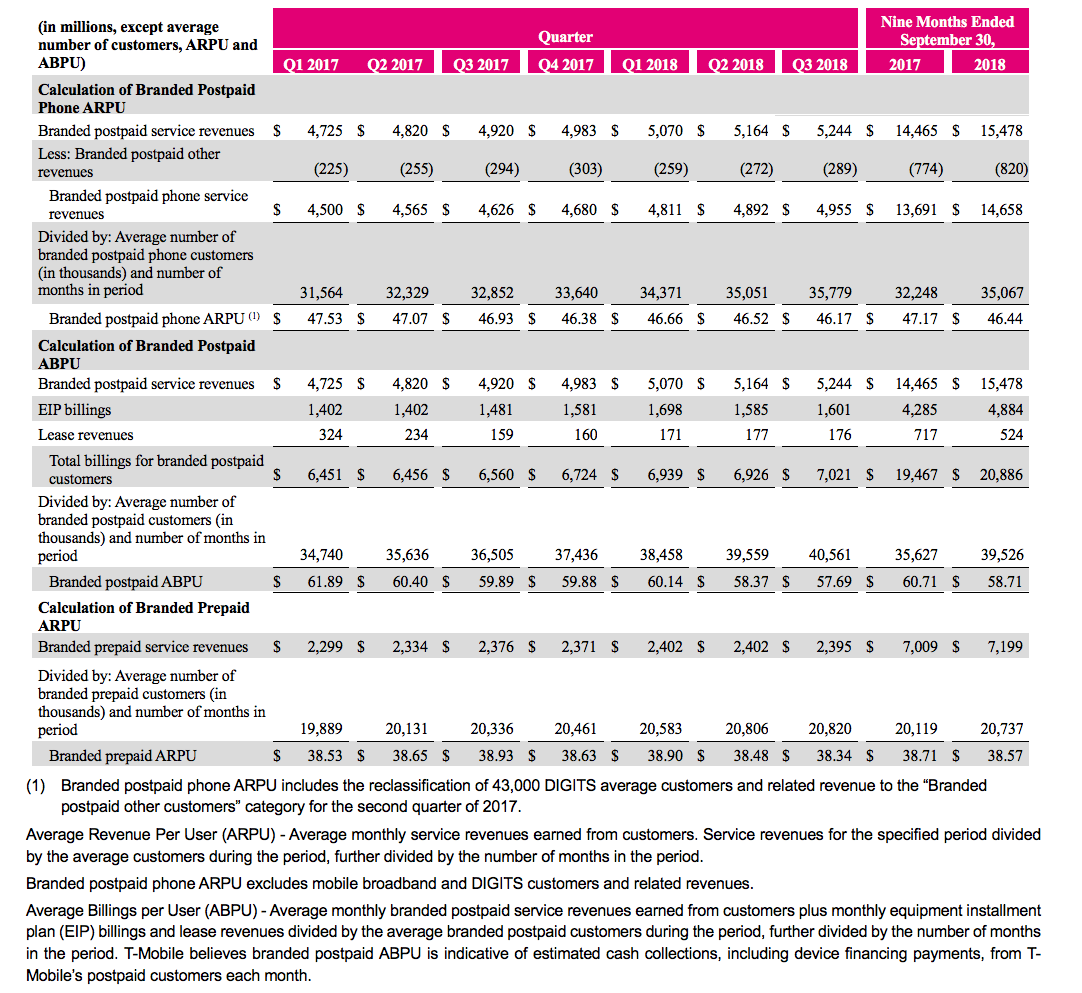Record Financial Performance
(all percentages year-over-year)
- Record Service revenues of $8.1 billion, up 6% — led the industry in YoY growth for the 18th consecutive quarter
- Record Total revenues of $10.8 billion, up 8% — led the industry in YoY growth once again
- Strong Net income of $795 million, up 45% and diluted earnings per share (EPS) of $0.93, up 48%
- Record Adjusted EBITDA(1) of $3.2 billion, up 15%
- Net cash provided by operating activities(3) of $914 million for Q3 2018 and $2.9 billion for YTD 2018
- Free Cash Flow(1)(3) of $890 million for Q3 2018 and $2.3 billion for YTD 2018
Industry-Leading Customer Growth
- 1.6 million total net additions — 22nd consecutive quarter with more than 1 million net additions
- 1.1 million total branded postpaid net additions — led the industry once again
- 774,000 branded postpaid phone net additions — led the industry for the 19th consecutive quarter
- 35,000 branded prepaid net additions — “MetroTM by T-Mobile” launched on October 8th
- Record low Q3 branded postpaid phone churn of 1.02% — down 21 bps YoY compared to down 15 bps in Q2 2018
Network Expansion Continues
- T-Mobile now covers 324 million people with 4G LTE - targeting 325 million people by year-end 2018
- Aggressive deployment of 600 MHz in Q3 2018, reaching more than 1,500 cities and towns in 37 states and Puerto Rico
- 21 devices currently compatible with 600 MHz including latest iPhone generation
- Fastest 4G LTE network for 19th consecutive quarter based on analysis by Ookla® of Speedtest Intelligence® data
Continued Strong Outlook for 2018
- Increased and narrowed target for branded postpaid net customer additions to 3.8 to 4.1 million
- Net income is not available on a forward-looking basis(2)
- Increased and narrowed Adjusted EBITDA target to $11.8 to $12.0 billion including leasing revenues of $0.6 to $0.7 billion(1) (leasing revenues now expected at the high end of the guidance range)
- Cash purchases of property and equipment, excluding capitalized interest, of $4.9 to $5.3 billion, unchanged from the prior target range, still expected to come in at the high end of the range
- Three-year compound annual growth rates (CAGRs) for Net cash provided by operating activities and Free Cash Flow from FY 2016 to FY 2019 also unchanged at 7% - 12% and 46% - 48%, respectively(1)(3)
- Adjusted EBITDA is a non-GAAP financial measure and Free Cash Flow is a non-GAAP financial metric. These non-GAAP financial items should be considered in addition to, but not as a substitute for, the information provided in accordance with GAAP. Reconciliations for these non-GAAP financial items to the most directly comparable financial items based on GAAP as of September 30, 2018 are provided in the Reconciliation of Non-GAAP Financial Measures to GAAP Financial Measures tables.
- We are not able to forecast net income on a forward-looking basis without unreasonable efforts due to the high variability and difficulty in predicting certain items that affect GAAP net income including, but not limited to, income tax expense, stock based compensation expense and interest expense. Adjusted EBITDA should not be used to predict net income as the difference between the two measures is variable.
- In Q1 2018, the adoption of the new cash flow accounting standard resulted in a reclassification of cash flows related to the deferred purchase price from securitization transactions from operating activities to investing activities. In addition, cash flows related to debt prepayment and extinguishment costs were reclassified from operating activities to financing activities. In Q1 2018, we redefined Free Cash Flow to reflect the above changes in classification and present cash flows on a consistent basis for investor transparency. The effects of this change are applied retrospectively and are provided in the Reconciliation of Non-GAAP Financial Measures to GAAP Financial Measures tables.
T-Mobile US, Inc. (NASDAQ: TMUS) reported another record-breaking quarter along with industry-leading branded postpaid phone customer growth. T-Mobile continues to drive its business beyond expectations - despite the work underway to close its pending merger with Sprint. In Q3, the Company delivered its best financials ever and very strong operational results - record-high service and total revenues, strong net income and record Adjusted EBITDA, and record-low Q3 postpaid phone churn. The Un-carrier strategy is all about putting customers first, which continues to prove to be the best way to deliver sustained, industry-leading results. T-Mobile continues to balance growth and profitability - delivering strong results in both categories for the third quarter of 2018.
T-Mobile once again outperformed the competition as the Company continues to expand into new geographies and customer segments, while setting the standard for customer experience. This has resulted in another quarter of accelerating growth in postpaid phone net additions. The Un-carrier again led the industry in the third quarter growing nearly 75% faster than the expected aggregate postpaid phone net additions of Verizon, AT&T, Sprint, Comcast, and Charter combined and more than 2.6 times the net additions of our next closest competitor, Verizon. In addition, the Company delivered record-low Q3 postpaid phone churn of 1.02% - the best result for a third quarter in Company history.
“T-Mobile delivered ANOTHER record-breaking quarter! We continue to drive our business beyond expectations and despite the work underway to close the merger, we delivered our best financials ever in Q3,” said John Legere, CEO of T-Mobile. “Our customer growth accelerated again, benefiting from the investments we are making in network and in customer experience, leading to 22 quarters in a row with more than 1 million net customer additions. I couldn’t be more proud of the T-Mobile team!”
Record Financial Performance
T-Mobile posted record-high service and total revenues, and Q3 marks the 18th quarter in a row where we led the industry in year-over-year service revenue percentage growth. In addition, the Company posted strong net income and record Adjusted EBITDA.
- Total service revenues increased 6% year-over-year to a record-high $8.1 billion, which marked the 18th consecutive quarter of leading the industry in year-over-year service revenue percentage growth.
- Total revenues increased 8% year-over-year to a record-high $10.8 billion, driven primarily by growth in service revenues and equipment revenues.
- Branded postpaid phone Average Revenue per User (ARPU) was $46.17 in Q3 2018, down 0.8% from Q2 2018 and 1.6% from Q3 2017. Sequentially, the decrease was primarily due to the continued adoption of tax inclusive plans, including from the growing success of new customer segments such as T-Mobile for Business, T-Mobile ONE Unlimited 55+ and T-Mobile ONE Military. Year-over-year, the decrease was primarily due to the continued adoption of tax inclusive plans, including the growing success of new customer segments such as T-Mobile for Business, T-Mobile ONE Unlimited 55+ and T-Mobile ONE Military, as well as a reduction in certain non-recurring charges including the noncash net benefit from Data Stash. These decreases were partially offset by a net reduction in service promotional activities.
- Branded prepaid ARPU was $38.34 in Q3 2018, down 1.5% from Q3 2017.
- Net income increased 45% year-over-year to a strong $795 million in Q3 2018. The positive impacts to net income in Q3 2018 from the adoption of the new revenue standard and hurricane related reimbursements, net of costs, were $101 million and $88 million, respectively. The negative impact to net income in Q3 2018 from the proposed Sprint transaction was $53 million.
- EPS increased by $0.30 to $0.93 in Q3 2018, up 48% year-over-year. The positive impacts to EPS in Q3 2018 from the adoption of the new revenue standard and hurricane related reimbursements, net of costs, were $0.12 and $0.10, respectively. The negative impact to EPS in Q3 2018 from the proposed Sprint transaction was $0.06.
- Adjusted EBITDA increased 15% year-over-year to a record-high $3.2 billion in Q3 2018, primarily due to higher operating income. The positive impacts to Adjusted EBITDA in Q3 2018 were $136 million from the adoption of the new revenue standard, and $138 million from hurricane-related reimbursements, net of costs, compared to costs incurred related to hurricanes of $148 million for Q3 2017.
- Cash purchases of property and equipment decreased 5% year-over-year to $1.4 billion and included expenditures for our deployment of low band spectrum, including 600 MHz, and capitalized interest of $101 million and $29 million in Q3 2018 and Q3 2017, respectively.
- Net cash provided by operating activities decreased 27.0% year-over-year to $914 million in Q3 2018. The decrease resulted from higher net cash outflows from working capital including a paydown of accounts payable and a build up of inventories with the launch of the new iPhone generation as well as an increase in accounts receivable. These decreases were partially offset by an increase in Net income and an increase in net non-cash adjustments to Net income. For the first nine months of 2018, net cash provided by operating activities amounted to $2.9 billion, down 1% year-over-year.
- Free Cash Flow decreased 3% year-over-year to $890 million in Q3 2018. Lower net cash provided by operating activities was offset by higher proceeds related to our deferred purchase price from securitization transactions and lower cash purchases of property and equipment. For the first nine months of 2018, Free Cash Flow amounted to $2.3 billion, up 47% year-over-year.
Industry-Leading Customer Growth
T-Mobile continues to deliver industry-leading customer growth, and Q3 2018 was no different. We once again led the industry in branded postpaid phone customer net additions, and expect to capture more than 60% of industry growth. Customers continue to choose the Un-carrier over the competition as we put all our energy and efforts into giving more to our customers without asking more from them.
- Total net customer additions were 1.6 million in Q3 2018, bringing our total customer count to 77.2 million. Q3 2018 marked the 22nd straight quarter in which T-Mobile generated more than 1 million total net customer additions.
- Branded postpaid net customer additions were 1.1 million in Q3 2018, up 262,000 from Q3 2017 and led the industry. Strength in postpaid phone net additions and postpaid other net additions, driven by wearables, drove the year-over-year increase.
- Branded postpaid phone net customer additions were 774,000 in Q3 2018, up 179,000 from Q3 2017. This marks the 19th consecutive quarter in which T-Mobile led the industry in this category. Branded postpaid phone net customer additions increased due to lower churn, continued growth in existing and Greenfield markets and the growing success of new customer segments such as T-Mobile for Business, T-Mobile ONE Unlimited 55+ and T-Mobile ONE Military.
- Branded postpaid other net customer additions were 305,000 in Q3 2018, up 83,000 from Q3 2017. Year-over-year the increase was due to higher gross customer additions from wearables.
- Branded postpaid phone churn was a Q3 record-low of 1.02% in Q3 2018, down 21 basis points from Q3 2017, primarily due to increased customer satisfaction and loyalty from ongoing improvements to network quality, industry-leading customer service and the overall value of our offerings in the marketplace. The 21 basis point improvement in branded postpaid phone churn in Q3 2018 was an acceleration compared to the 15 basis point reduction in Q2 2018.
- Branded prepaid net customer additions were 35,000 in Q3 2018, down 191,000 from Q3 2017. Branded prepaid net additions decreased primarily due to increased competitive activity in the marketplace, partially offset by lower migrations to branded postpaid plans. On October 8, 2018, MetroPCS was re-branded “MetroTM by T-Mobile” and launched new unlimited rate plans that include premium features such as Amazon Prime and Google One.
- Branded prepaid churn was 4.12% in Q3 2018, down 13 basis points compared to Q3 2017.
Network Expansion Continues
We continue to increase and expand the coverage and capacity of our network to better serve our customers. Our rapid deployment of 600 MHz provides customers with even better coverage and sets the stage for nationwide 5G.
Highlights from Q3 2018 included:
- Operating America’s Fastest 4G LTE network. In Q3 2018, we were once again the nation’s fastest LTE network, realizing average 4G LTE download speeds of 31.7 Mbps, and average 4G LTE upload speeds of 11.5 Mbps. This was the 19th consecutive quarter that we have led the industry in both download and upload speeds based on analysis by Ookla® of Speedtest Intelligence® data.
- Expanding our coverage breadth. T-Mobile now covers 324 million people with 4G LTE. By the end of 2018, we are targeting to cover 325 million people.
- Clearing and deploying 600 MHz spectrum. At the end of Q3 2018, T-Mobile owned a nationwide average of 31 MHz of 600 MHz low band spectrum. We expect to clear spectrum covering approximately 132 million POPs by year-end 2018 and target approximately 265 million POPs by year-end 2019. 600 MHz deployments continue at an accelerated pace with spectrum covering more than 1,500 cities and towns in 37 states and Puerto Rico already lit up. Combining 600 MHz and 700 MHz, we have deployed low band spectrum to 291 million POPs. We now have 21 devices compatible with 600 MHz including the latest iPhone generation.
- 5G update. T-Mobile is building out 5G in six of the Top 10 markets, including New York and Los Angeles, and hundreds of cities across the U.S. in 2018. This network will be ready for the introduction of the first 5G smartphones in 2019. We plan on the delivery of a nationwide 5G network in 2020.
Continued Strong 2018 Outlook
In 2018, we expect postpaid net customer additions between 3.8 and 4.1 million, an increase and narrowing from the prior target range of 3.0 to 3.6 million.
Net income is not available on a forward looking basis.
Adjusted EBITDA is now expected to be between $11.8 and $12.0 billion, an increase and narrowing from the prior target range of $11.5 to $11.9 billion. Our Adjusted EBITDA target includes leasing revenues of $0.6 to $0.7 billion, unchanged from the prior guidance but we now expect leasing revenues to be at the high end of the guidance range. Including the estimated impact of the new revenue standard, Adjusted EBITDA is expected to increase by an additional $0.2 to $0.5 billion for a total guidance range of $12.0 to $12.5 billion.
For full-year 2018, we continue to expect branded postpaid phone ARPU to be generally stable compared to full-year 2017, excluding the impact from the new revenue standard.
Cash purchases of property and equipment, excluding capitalized interest, are expected to be between $4.9 and $5.3 billion, unchanged from the prior target range, and are still expected to come in at the high end of the range. This includes expenditures for 5G deployment.
The adoption of the new cash flow accounting standard resulted in a reclassification of cash flows related to our deferred purchase price from securitization transactions from operating activities to investing activities. In addition, cash flows related to debt prepayment and extinguishment costs were reclassified from operating activities to financing activities. In Q1 2018, we redefined Free Cash Flow to reflect the above changes in classification and present cash flows on a consistent basis for investor transparency. Please see the reconciliation of non-GAAP measures in this earnings release for details on the revised definition, which was applied retroactively to 2017.
The three-year CAGR guidance (2016 - 2019) for net cash provided by operating activities and Free Cash Flow is unchanged at 7% - 12% and 46% - 48%, respectively.
Financial Results
For more details on T-Mobile’s Q3 2018 financial results, including the Investor Factbook with detailed financial tables and reconciliations of certain historical non-GAAP measures disclosed in this release to the most comparable measures under GAAP, please visit T-Mobile US, Inc.’s Investor Relations website at http://investor.t-mobile.com.
T-Mobile Social Media
Investors and others should note that we announce material financial and operational information to our investors using our investor relations website, press releases, SEC filings and public conference calls and webcasts. We also intend to use the @TMobileIR Twitter account (https://twitter.com/TMobileIR) and the @JohnLegere Twitter (https://twitter.com/JohnLegere), Facebook and Periscope accounts, which Mr. Legere also uses as a means for personal communications and observations, as means of disclosing information about the Company and its services and for complying with its disclosure obligations under Regulation FD. The information we post through these social media channels may be deemed material. Accordingly, investors should monitor these social media channels in addition to following our press releases, SEC filings and public conference calls and webcasts. The social media channels that we intend to use as a means of disclosing the information described above may be updated from time to time as listed on our investor relations website.
About T-Mobile US, Inc.
As America’s Un-carrier, T-Mobile US, Inc. (NASDAQ: TMUS) is redefining the way consumers and businesses buy wireless services through leading product and service innovation. Our advanced nationwide 4G LTE network delivers outstanding wireless experiences to 77.2 million customers who are unwilling to compromise on quality and value. Based in Bellevue, Washington, T-Mobile US provides services through its subsidiaries and operates its flagship brands, T-Mobile and MetroPCS. For more information, please visit https://www.t-mobile.com or join the conversation on Twitter using $TMUS.
Q3 2018 Earnings Call, Livestream and Webcast Access Information
Access via Phone (audio only)
Date: October 30, 2018
Time: 4:30 p.m. (EDT)
Call-in Numbers: 866-575-6534
International: +1-786-460-7205
Participant Passcode: 5309287
Please plan on accessing the earnings call ten minutes prior to the scheduled start time.
Access via Social Media
The @TMobileIR Twitter account will live-tweet the earnings call.
Submit Questions via Text, Twitter or Facebook
Text: Send a text message to 313131, enter the keyword TMUS followed by a space
Twitter: Send a tweet to @TMobileIR or @JohnLegere using $TMUS
Facebook: Post a comment to John Legere’s Facebook Earnings post
Access via Webcast:
The earnings call will be broadcast live via our Investor Relations website at http://investor.t-mobile.com. A replay of the earnings call will be available for two weeks starting shortly after the call concludes and can be accessed by dialing 888-203-1112 (toll free) or +1 719-457-0820 (international). The passcode required to listen to the replay is 5309287.
To automatically receive T-Mobile financial news by e-mail, please visit the T-Mobile Investor Relations website, http://investor.t-mobile.com, and subscribe to E-mail Alerts.
Forward-Looking Statements
This news release includes forward-looking statements within the meaning of the Private Securities Litigation Reform Act of 1995. All statements other than statements of historical fact, including information concerning T-Mobile US, Inc.’s future results of operations, are forward-looking statements. These forward-looking statements are generally identified by the words “anticipate,” “expect,” “believe,” “intend,” “may,” “could,” or similar expressions. Forward-looking statements are based on current expectations and assumptions, which are subject to risks and uncertainties and may cause actual results to differ materially from the forward-looking statements. Important factors that could affect future results and cause those results to differ materially from those expressed in the forward-looking statements include, among others, the following: the failure to obtain, or delays in obtaining, required regulatory approvals for the merger contemplated under the Business Combination Agreement with Sprint Corporation (“Sprint”), and related transactions (collectively, the “Transactions”) and the risk that such approvals may result in the imposition of conditions that could adversely affect the combined company or the expected benefits of the Transactions, or the failure to satisfy any of the other conditions to the Transactions on a timely basis or at all; the occurrence of events that may give rise to a right of one or both of the parties to terminate the Business Combination Agreement with Sprint; adverse effects on the market price of our common stock or on our or Sprint’s operating results because of a failure to complete the Transactions in the anticipated timeframe or at all; inability to obtain the financing contemplated to be obtained in connection with the Transactions on the expected terms or timing or at all; the ability of us, Sprint and the combined company to make payments on debt or to repay existing or future indebtedness when due or to comply with the covenants contained therein; adverse changes in the ratings of our or Sprint’s debt securities or adverse conditions in the credit markets; negative effects of the announcement, pendency or consummation of the Transactions on the market price of our common stock and on our or Sprint’s operating results, including as a result of changes in key customer, supplier, employee or other business relationships; significant costs related to the Transactions, including financing costs, and unknown liabilities of Sprint or that may arise; failure to realize the expected benefits and synergies of the Transactions in the expected timeframes or at all; costs or difficulties related to the integration of Sprint’s network and operations into our network and operations; the risk of litigation or regulatory actions related to the Transactions; the inability of us, Sprint or the combined company to retain and hire key personnel; the risk that certain contractual restrictions contained in the Business Combination Agreement with Sprint during the pendency of the Transactions could adversely affect our or Sprint’s ability to pursue business opportunities or strategic transactions; adverse economic or political conditions in the U.S. and international markets; competition, industry consolidation, and changes in the market for wireless services, which could negatively affect our ability to attract and retain customers; the effects of any future merger, investment, or acquisition involving us, as well as the effects of mergers, investments, or acquisitions in the technology, media and telecommunications industry; challenges in implementing our business strategies or funding our operations, including payment for additional spectrum or network upgrades; the possibility that we may be unable to renew our spectrum licenses on attractive terms or acquire new spectrum licenses at reasonable costs and terms; difficulties in managing growth in wireless data services, including network quality; material changes in available technology and the effects of such changes, including product substitutions and deployment costs and performance; the timing, scope and financial impact of our deployment of advanced network and business technologies; the impact on our networks and business from major technology equipment failures; breaches of our and/or our third-party vendors’ networks, information technology and data security, resulting in unauthorized access to customer confidential information; natural disasters, terrorist attacks or similar incidents; unfavorable outcomes of existing or future litigation; any changes in the regulatory environments in which we operate, including any increase in restrictions on the ability to operate our networks and data privacy laws; any disruption or failure of our third parties’ or key suppliers’ provisioning of products or services; material adverse changes in labor matters, including labor campaigns, negotiations or additional organizing activity, and any resulting financial, operational and/or reputational impact; changes in accounting assumptions that regulatory agencies, including the Securities and Exchange Commission (“SEC”), may require, which could result in an impact on earnings; changes in tax laws, regulations and existing standards and the resolution of disputes with any taxing jurisdictions; the possibility that the reset process under our trademark license with Deutsche Telekom AG results in changes to the royalty rates for our trademarks; and other risks described in our filings with the SEC. You should not place undue reliance on these forward-looking statements. We do not undertake to update forward-looking statements, whether as a result of new information, future events or otherwise, except as required by law.Press Contact:Media Relations
Press Contact
T-Mobile US, Inc
[email protected]
http://newsroom.t-mobile.com
Investor Relations Contact
Nils Paellmann
T-Mobile US, Inc.
212-358-3210
[email protected]
http://investor.t-mobile.com
T-Mobile US, Inc.
Reconciliation of Non-GAAP Financial Measures to GAAP Financial Measures (Unaudited)
This Press Release includes non-GAAP financial measures. The non-GAAP financial measures should be considered in addition to, but not as a substitute for, the information provided in accordance with GAAP. Reconciliations for the non-GAAP financial measures to the most directly comparable GAAP financial measures are provided below. T-Mobile is not able to forecast net income on a forward looking basis without unreasonable efforts due to the high variability and difficulty in predicting certain items that affect GAAP net income including, but not limited to, income tax expense, stock-based compensation expense and interest expense. Adjusted EBITDA should not be used to predict net income as the difference between the two measures is variable.
Adjusted EBITDA is reconciled to net income as follows:
Adjusted EBITDA - Earnings before Interest expense, net of Interest income, Income tax expense, depreciation and amortization expense, non-cash Stock-based compensation and certain expenses not reflective of T-Mobile’s ongoing operating performance. Adjusted EBITDA is a non-GAAP financial measure utilized by T-Mobile’s management to monitor the financial performance of our operations. T-Mobile uses Adjusted EBITDA internally as a metric to evaluate and compensate its personnel and management for their performance, and as a benchmark to evaluate T-Mobile’s operating performance in comparison to its competitors. Management believes analysts and investors use Adjusted EBITDA as a supplemental measure to evaluate overall operating performance and facilitate comparisons with other wireless communications companies because it is indicative of T-Mobile’s ongoing operating performance and trends by excluding the impact of interest expense from financing, non-cash depreciation and amortization from capital investments, non-cash stock-based compensation, network decommissioning costs and costs related to the Transactions, as they are not indicative of T-Mobile’s ongoing operating performance, as well as certain other nonrecurring income and expenses. Adjusted EBITDA has limitations as an analytical tool and should not be considered in isolation or as a substitute for income from operations, net income or any other measure of financial performance reported in accordance with U.S. Generally Accepted Accounting Principles (“GAAP”).
T-Mobile US, Inc.
Reconciliation of Non-GAAP Financial Measures to GAAP Financial Measures (continued) (Unaudited)
Net debt (excluding Tower obligations) to last twelve months Net income and Adjusted EBITDA ratios are calculated as follows:
Free Cash Flow(1) is calculated as follows:
T-Mobile US, Inc.
Reconciliation of Non-GAAP Financial Measures to GAAP Financial Measures (continued) (Unaudited)
Free Cash Flow(1) three-year CAGR is calculated as follows:
T-Mobile US, Inc.
Reconciliation of Operating Measures to Service Revenues (Unaudited)












